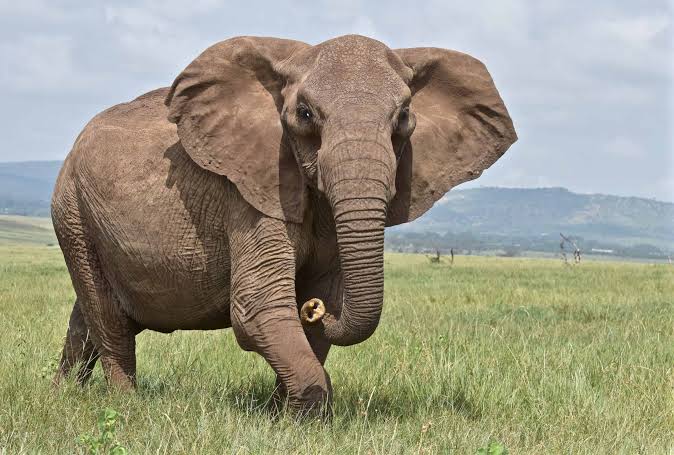“Salute to the Elephant” is an oral praise-chant to the elephant, a large animal found in Africa and Asia. It highlights the elephant’s attributes: its size, weight, strength, destructive power, and economic importance. The poem describes the elephant as huge, strong, and capable of causing destruction. It also emphasizes its economic value due to its ivory tusks. The poem inspires awe and respect for the greatness of the elephant.
“Salute to the Elephant” is a translation by Prof. Adeboye Babalola of the Yoruba hunters’ chant called Ijala, which is part of an oral tradition passed down through generations. These chants are praise-songs dedicated to animals or specific situations. They are meant to be recited, chanted, or sung. When translated into English or any other language, traditional poems like this one lose some of their rhythm and lyrical qualities.
Ijala is an epic poem with salute form developed from hunting among the Yoruba people of the Southwest Nigeria. It is an oral poetry sung by hunters during their festivals to tell stories of the valour of a particular hunter and his hunting expeditions. Ijala is also performed as dirge to mourn a departed hunter. In the case of “Salute to the Elephant,” it is an Ijala poem that praises the valour of the elephant.
Read: Traditional Poem: Salute to the Elephant
As an oral poem, its power comes from the use of imagery associated with sound. This includes onomatopoeia (words that echo their meaning), alliteration (repetition of consonant sounds), and assonance (repetition of vowel sounds). These sound-related devices give the poem an oral quality.
“Salute to the Elephant” can be divided into three segments. The first introduces the physical qualities of the elephant, the second emphasizes its association with death and destruction, and the third further explores its attributes. The poem is written in free verse with no specific rhyme scheme, and the lines are uneven in length, adding to the sense of the elephant’s size and strength. The flow of the poem resembles an incantation, as is typical of oral poetry.
The poem describes the awesome size of the elephant: “huge as a hill” (l. 2), “Mountainous Animal, Huge Beast” (l. 7). It also paints an explicit picture of the elephant’s molar which is “as wide as palm-oil pits in Ijesaland” (l. 29)
Its enormous weight is referenced to by statements such as “heavy tread” (l. 11), “sturdy and alert” (l. 15), “One tooth of his is a porter’s load” (l. 32), “carries mortars and yet walks with a staggering gait” (l. 36), and “treading ponderously” (l. 37).
The poem further describes the extraordinary power of the elephant in such expressions as “demon who snaps tree branches into many pieces and moves on to the forest farm” (l. 4), “who swallows palm-fruit bunches whole, even with the spiky pistil-cells” (l. 12), “who single-handed causes a tremor in a dense tropical forest” (l. 14), and “whose teeth are like shafts” (l. 31).
In the following lines, the poem projects the elephant’s destructive ability: “demon, flapping fans of war” (l. 3), “who snaps tree branches into many pieces and moves on to the forest farm” (l. 4), “who ignores ‘I have fled to my father for refuge’/Let alone ‘to mother'” (l. 5 and 6), “who tears a man like a garment/And hangs him on a tree” (l. 7 and 8), and “praise named Laaye, ‘O death, please stop following me” (l. 22).
Lines 1 and 3 are emphatic about the economic importance of the elephant, pointing the commercial value of its ivory tusks: “possessor of a savings-basket full of money” (l. 1) and “enfolded by honour” (l. 3).
Figures of Speech
Some of the noticeable figures of speech in “Salute to the Elephant” include repetition, metaphor, simile, hyperbole and personification.
Repetition
The poem uses repetition for emphasis, such as the repeated salutation phrase “O elephant,” repeated not less than fifteen times in the poem. The word “huge” is also repeated to draw attention to the elephant’s size. Additionally, the statement about the hunter’s boast being repeated with a slight modification emphasizes the fear hunters have of elephants.
Metaphor
The poem uses metaphorical language to describe the elephant. For example, it refers to the elephant’s tusks as a “savings-basket full of money” and its head as a “porter’s-knee” and a “burden.” Other metaphors highlight the negative aspects of the elephant, like “Demon” and “death.”
Simile
Similes are used to create exaggerated images of the elephant. Examples include comparing the elephant’s size to a hill, describing how it tears a man like a garment, describing the stoutness and thickness of the elephant’s neck, and drawing attention to the strength and sharpness of the pointed pair of tusks: “huge as a hill” (line 2), “tears a man like a garment” (line 7), “looks back with difficulty like a person suffering from a sprained neck’ (line 19), “molar teeth… as wide as palm-oil pits in Ijesaland’ (line 29), and ‘whose teeth are like shafts’ (line 31).
Hyperbole
The poem employs exaggerated language to emphasize the qualities of the elephant, such as its size and strength. It describes the elephant as causing a tremor in a dense forest and being a “lord of the forest” (l. 30). It describes the elephant to be as “huge as a hill” (l. 2) and says its “molar teeth are as wide as palm-oil pits in Ijesaland” (line 29).
Personification
There is one instance of personification in the poem, where the elephant is referred to as a “veritable ferry-man,” in line 22, to emphasize its association with death.
Onomatopoeia
“Flapping” in line 3 suggests the sound made by the broad, fan-like cars of the elephant while “snaps” (line 4) suggests the sound of tree branches breaking as the elephant rampages.
Alliteration
Examples of alliteration in “Salute to the Elephant” are: “huge as a hill” (line 2), “flapping fans of war” (line 3), “fled to my father for refuge” (line 5), “forest farm” (line 4), “stands sturdy” (line 15), “part and parcel of the elephant’s appellation” (line 23), and “palm-oil pits” (line 29) and “beast-of-burden” (line 33).
Assonance
Some of the examples of assonance in the poem are: “massive animal, blackish-grey” (line 13), “elephant who is a veritable ferry-man” (line 24), and “praise named Laaye” (line 22).
Themes
Themes in “Salute to the Elephant” include awe and grandeur of nature, destructive power, fear and reverence, and contrast and paradox.
Awe and Grandeur of Nature: The poem evokes a sense of awe and admiration for the elephant, highlighting its immense size, strength, and power. It emphasizes the grandeur of nature and the wonders of creation.
Destructive Power: The poem also explores the destructive abilities of the elephant, portraying it as a force to be reckoned with. It describes how the elephant can break tree branches, tear a man apart, and cause tremors in the forest. This theme reflects the potential for both creation and destruction in the natural world.
Fear and Reverence: The poem conveys a sense of fear and reverence towards the elephant. It uses metaphors and exaggerated language to depict the elephant as a formidable and even menacing creature. This theme explores the mix of admiration, respect, and trepidation that the elephant inspires.
Contrast and Paradox: The poem presents contrasting images of the elephant, highlighting its immense size and strength alongside its association with death and destruction. It portrays the elephant as both a symbol of awe-inspiring greatness and a potentially dangerous force.
 WHATSAPP: Click HERE to join the new Literature PADI WhatsApp group to receive latest updates on your phone and for further literary discussions!
WHATSAPP: Click HERE to join the new Literature PADI WhatsApp group to receive latest updates on your phone and for further literary discussions!










